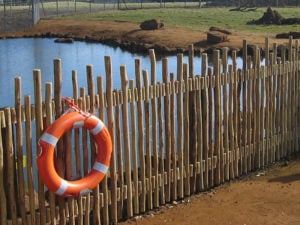
The newest addition to the zebra paddock at Peak Wildlife Park is a thatched umbrella supplied by Africa Roofing UK.
The zoo’s General Manager, James Butler explains:
“Zoo theming is really important. These kinds of touches create the illusion of an African village for our visitors and provide the perfect backdrop to showcase our Maneless Zebras.”
This dazzle of zebras is an endangered sub-species of Plains Zebras. Originally from north-west of Kenya, this collection is only two in the UK.
Adapted from an existing metal pole and fitted with a tailor-made Cape Reed canopy, the parasol provides cover for fillies Zara and Kayla and new male arrival, Horus.
Animal keeper, Amy Johnson adds:
“The zebras are loving their new umbrella. It sits on a hard-standing area so we’re able to carry out health checks and care for their hooves while they shelter.”
Horus earns his stripes
One-and-a-half-year-old Horus came from Czechoslovakia two months ago. He’s a genetic match to Zara aged 4 and 3-year-old Kayla. The hope is that the herd will expand in time.
He’s enjoying something of a “honeymoon period” with both females acting quite maternally towards him. This is expected to change. As he gets older, they will test his character as he forms a “harem”.
Zebras breed mainly in the wet season, which is probably going to be longer in the moors of Staffordshire than on the African Plains. Females give birth after about a 393 day gestation period. Amazingly, the young are able to stand almost immediately and after a week graze for themselves.
The question remains where did these striking equids get their stripes?
There are many theories. Research suggests their distinctive coat repel flies. Another such theory is that the stripes act as a convector of heat and help the animal to regulate their temperature. Other suggestions are that they help strengthen bonds and stimulate grooming. Some have even said the reason for their stripes may be to help protect zebras against predators.





